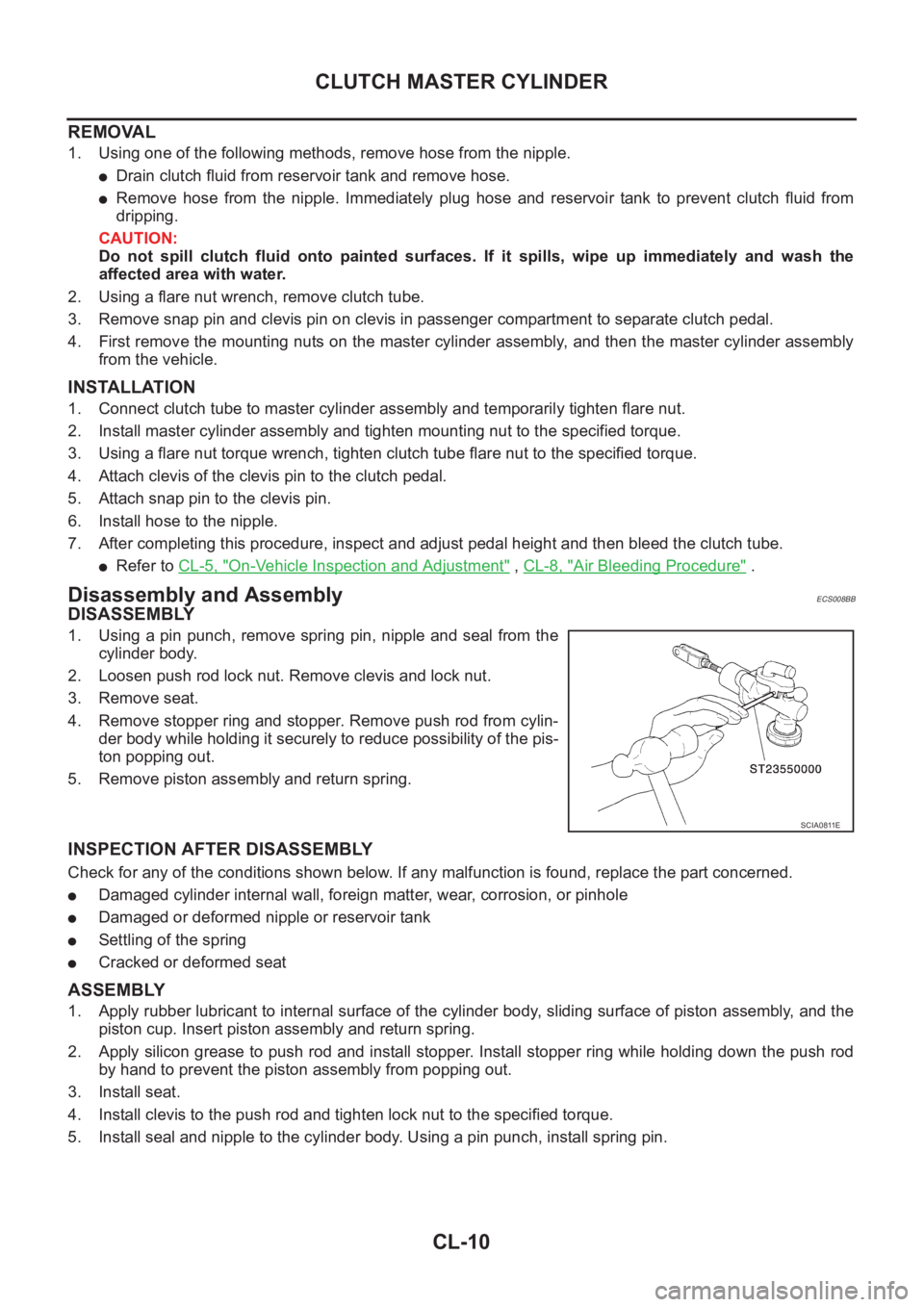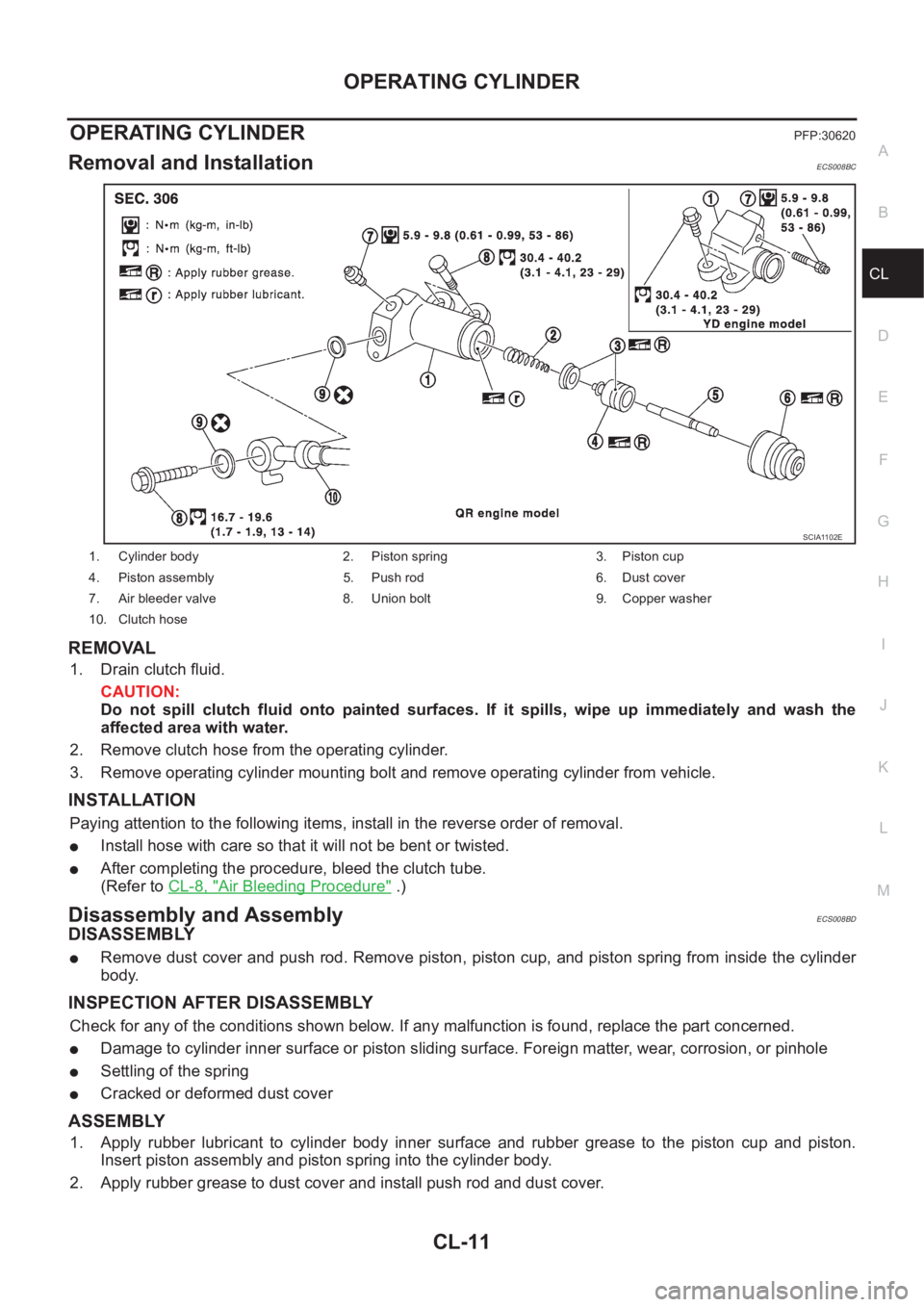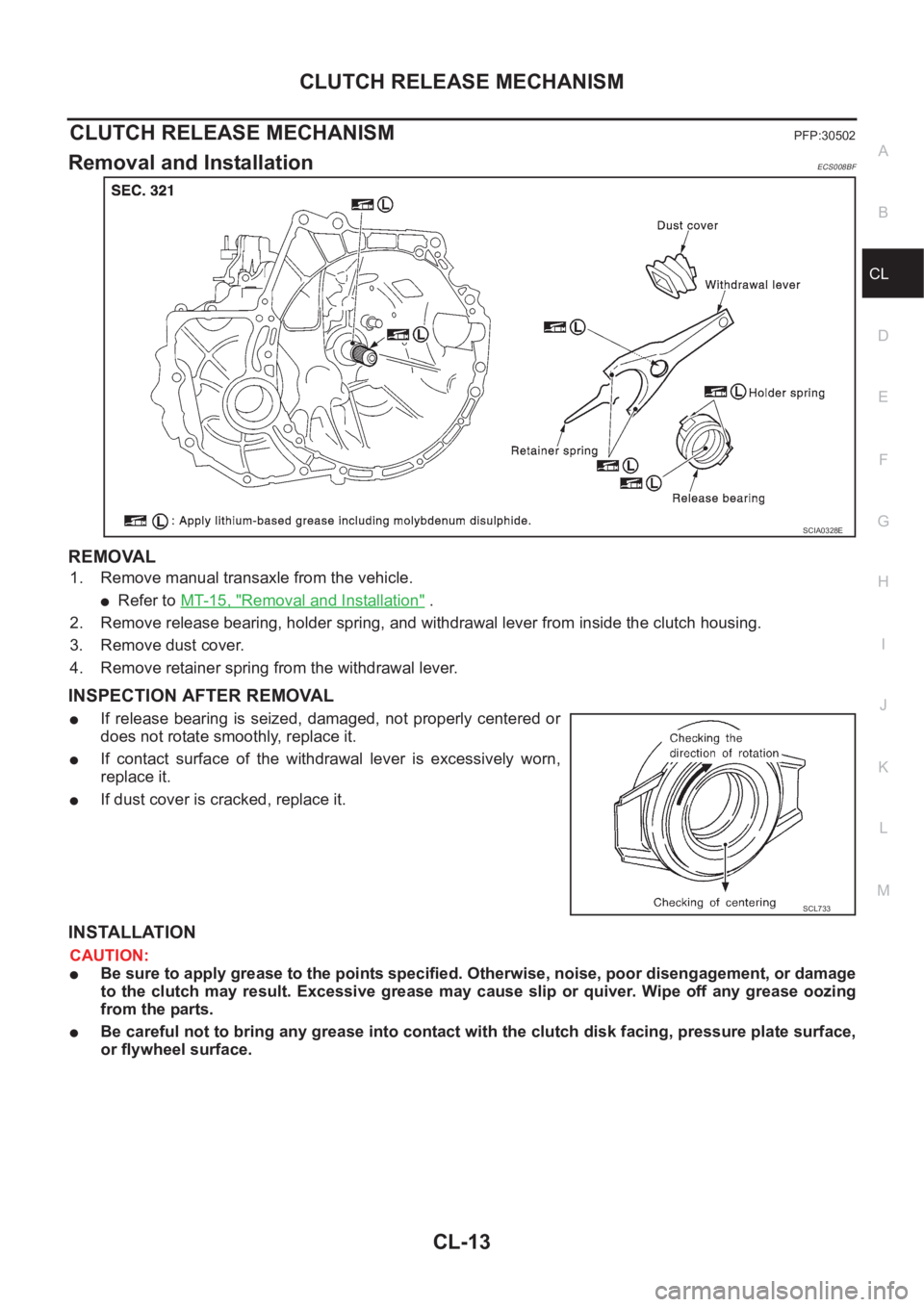Page 1965 of 3833
CLUTCH PEDAL
CL-7
D
E
F
G
H
I
J
K
L
MA
B
CL
NOTE:
Install clutch pedal assembly and adjust the pedal height. Tighten pedal stopper bolt (or ASCD clutch switch)
to the specified torque.
INSPECTION AFTER REMOVAL
●Check clutch pedal for bend, damage, or a cracked weld. If bend, damage, or a cracked weld is found,
replace the clutch pedal.
●Check assist spring for settling. If settling is found, replace the assist spring.
Page 1966 of 3833
CL-8
CLUTCH FLUID
CLUTCH FLUID
PFP:00017
Air Bleeding ProcedureECS008B9
CAUTION:
●Monitor fluid level in the reservoir tank to make sure it does
not empty.
●Do not spill clutch fluid onto painted surfaces. If it spills,
wipe up immediately and wash the affected area with water.
●Bleed the operating cylinder.
1. Fill the master cylinder reservoir tank with new clutch fluid.
2. Connect a transparent vinyl hose to the air bleeder valve.
3. Depress the clutch pedal slowly and fully a few times at an inter-
val of 2 to 3 seconds and hold it.
4. With clutch pedal depressed, open air bleeder.
5. Close air bleeder valve.
6. Release clutch pedal and wait for 5 seconds.
7. Repeat steps 3 to 6 until no bubbles can be observed in the
brake fluid.
Air bleeder:
: 5.9 - 9.8 N·m (0.61 - 0.99 kg-m, 53 - 86 in-lb)
SCIA1098E
SCL839
Page 1967 of 3833
CLUTCH MASTER CYLINDER
CL-9
D
E
F
G
H
I
J
K
L
MA
B
CL
CLUTCH MASTER CYLINDERPFP:30610
Removal and InstallationECS008BA
—RHD model—
—LHD model—
SCIA0324E
1. Clevis pin 2. Snap pin 3. Clevis
4. Lock nut 5. Seat 6. Stopper ring
7. Stopper 8. Push rod 9. Piston assembly
10. Return spring 11. Cylinder body 12. Seal
13. Spring pin 14. Nipple 15. Clamp
16. Hose
SCIA1099E
1. Clevis pin 2. Snap pin 3. Clevis
4. Lock nut 5. Seat 6. Stopper ring
7. Stopper 8. Push rod 9. Piston assembly
10. Return spring 11. Cylinder body 12. Seal
13. Spring pin 14. Nipple 15. Clamp
16. Hose
Page 1968 of 3833

CL-10
CLUTCH MASTER CYLINDER
REMOVAL
1. Using one of the following methods, remove hose from the nipple.
●Drain clutch fluid from reservoir tank and remove hose.
●Remove hose from the nipple. Immediately plug hose and reservoir tank to prevent clutch fluid from
dripping.
CAUTION:
Do not spill clutch fluid onto painted surfaces. If it spills, wipe up immediately and wash the
affected area with water.
2. Using a flare nut wrench, remove clutch tube.
3. Remove snap pin and clevis pin on clevis in passenger compartment to separate clutch pedal.
4. First remove the mounting nuts on the master cylinder assembly, and then the master cylinder assembly
from the vehicle.
INSTALLATION
1. Connect clutch tube to master cylinder assembly and temporarily tighten flare nut.
2. Install master cylinder assembly and tighten mounting nut to the specified torque.
3. Using a flare nut torque wrench, tighten clutch tube flare nut to the specified torque.
4. Attach clevis of the clevis pin to the clutch pedal.
5. Attach snap pin to the clevis pin.
6. Install hose to the nipple.
7. After completing this procedure, inspect and adjust pedal height and then bleed the clutch tube.
●Refer to CL-5, "On-Vehicle Inspection and Adjustment" , CL-8, "Air Bleeding Procedure" .
Disassembly and AssemblyECS008BB
DISASSEMBLY
1. Using a pin punch, remove spring pin, nipple and seal from the
cylinder body.
2. Loosen push rod lock nut. Remove clevis and lock nut.
3. Remove seat.
4. Remove stopper ring and stopper. Remove push rod from cylin-
der body while holding it securely to reduce possibility of the pis-
ton popping out.
5. Remove piston assembly and return spring.
INSPECTION AFTER DISASSEMBLY
Check for any of the conditions shown below. If any malfunction is found, replace the part concerned.
●Damaged cylinder internal wall, foreign matter, wear, corrosion, or pinhole
●Damaged or deformed nipple or reservoir tank
●Settling of the spring
●Cracked or deformed seat
ASSEMBLY
1. Apply rubber lubricant to internal surface of the cylinder body, sliding surface of piston assembly, and the
piston cup. Insert piston assembly and return spring.
2. Apply silicon grease to push rod and install stopper. Install stopper ring while holding down the push rod
by hand to prevent the piston assembly from popping out.
3. Install seat.
4. Install clevis to the push rod and tighten lock nut to the specified torque.
5. Install seal and nipple to the cylinder body. Using a pin punch, install spring pin.
SCIA0811E
Page 1969 of 3833

OPERATING CYLINDER
CL-11
D
E
F
G
H
I
J
K
L
MA
B
CL
OPERATING CYLINDERPFP:30620
Removal and InstallationECS008BC
REMOVAL
1. Drain clutch fluid.
CAUTION:
Do not spill clutch fluid onto painted surfaces. If it spills, wipe up immediately and wash the
affected area with water.
2. Remove clutch hose from the operating cylinder.
3. Remove operating cylinder mounting bolt and remove operating cylinder from vehicle.
INSTALLATION
Paying attention to the following items, install in the reverse order of removal.
●Install hose with care so that it will not be bent or twisted.
●After completing the procedure, bleed the clutch tube.
(Refer to CL-8, "
Air Bleeding Procedure" .)
Disassembly and AssemblyECS008BD
DISASSEMBLY
●Remove dust cover and push rod. Remove piston, piston cup, and piston spring from inside the cylinder
body.
INSPECTION AFTER DISASSEMBLY
Check for any of the conditions shown below. If any malfunction is found, replace the part concerned.
●Damage to cylinder inner surface or piston sliding surface. Foreign matter, wear, corrosion, or pinhole
●Settling of the spring
●Cracked or deformed dust cover
ASSEMBLY
1. Apply rubber lubricant to cylinder body inner surface and rubber grease to the piston cup and piston.
Insert piston assembly and piston spring into the cylinder body.
2. Apply rubber grease to dust cover and install push rod and dust cover.
1. Cylinder body 2. Piston spring 3. Piston cup
4. Piston assembly 5. Push rod 6. Dust cover
7. Air bleeder valve 8. Union bolt 9. Copper washer
10. Clutch hose
SCIA1102E
Page 1970 of 3833
CL-12
CLUTCH PIPING
CLUTCH PIPING
PFP:30650
Removal and InstallationECS008BE
Carefully observe the following steps during clutch tube removal and installation.
●Do not spill clutch fluid onto painted surfaces. If it spills, wipe up immediately and wash the affected area
with water.
●To fix clutch hose on the bracket, position hose clasp on the
bracket locating embossment and drive the lock plate vertically
from above. Be careful not to bend or twist the hose. Do not
scratch or damage the clutch hose.
●Tighten clutch tube flare nut to the specified torque below:
●Tighten clutch hose union bolt to the specified torque:
CAUTION:
Do not reuse the copper washer.
●After installation, bleed the clutch tube.
(Refer to CL-8, "
Air Bleeding Procedure" .) : 15 - 17 N·m (1.5 - 1.8 kg-m, 11 - 13 ft-lb)
: 16.7 - 19.6 N·m (1.7 - 1.9 kg-m, 13 - 14 ft-lb)
SCIA0326E
Page 1971 of 3833

CLUTCH RELEASE MECHANISM
CL-13
D
E
F
G
H
I
J
K
L
MA
B
CL
CLUTCH RELEASE MECHANISMPFP:30502
Removal and InstallationECS008BF
REMOVAL
1. Remove manual transaxle from the vehicle.
●Refer to MT-15, "Removal and Installation" .
2. Remove release bearing, holder spring, and withdrawal lever from inside the clutch housing.
3. Remove dust cover.
4. Remove retainer spring from the withdrawal lever.
INSPECTION AFTER REMOVAL
●If release bearing is seized, damaged, not properly centered or
does not rotate smoothly, replace it.
●If contact surface of the withdrawal lever is excessively worn,
replace it.
●If dust cover is cracked, replace it.
INSTALLATION
CAUTION:
●Be sure to apply grease to the points specified. Otherwise, noise, poor disengagement, or damage
to the clutch may result. Excessive grease may cause slip or quiver. Wipe off any grease oozing
from the parts.
●Be careful not to bring any grease into contact with the clutch disk facing, pressure plate surface,
or flywheel surface.
SCIA0328E
SCL733
Page 1972 of 3833
CL-14
CLUTCH RELEASE MECHANISM
1. Following the instructions below, apply grease to the specified points.
CAUTION:
Wipe off any old grease, debris, or powdery residue left on the grease applying surfaces.
●Evenly apply a 1-mm thick coating of recommended grease to withdrawal lever and holder spring slid-
ing surface.
●Apply recommended grease to withdrawal lever ball pin contact surface and inner slots of the release
bearing. The grease surface should be level with the surrounding area.
●Apply a thin coat of recommended grease evenly to the release bearing sliding surface. Install release
bearing. Wipe off any excess grease that oozes from the parts and then remove release bearing.
2. Install in the reverse order of the removal.
SCL815